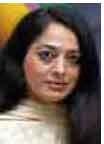| Spiritual Meditations | |
| 04 Jan 2011, NewAgeIslam.Com |
 On the 28th of September falls the 706th Urs, death anniversary of Hazrat Amir Khusrau, who lies buried inside the compound of Hazrat Nizamuddin Auliya’s dargah. Like most devotees, I follow the tradition of first offering prayers at Khusrau’s tomb before seeking blessings from his Master. I respect Khusrau’s genius, adore his music, love his poetry and seek his intercession to invoke the blessings of Hazrat Nizamuddin. In these tumultuous times, Khusrau’s legacy signifying India’s composite heritage and culture has become more relevant than ever. -- Sadia Dehlvi
On the 28th of September falls the 706th Urs, death anniversary of Hazrat Amir Khusrau, who lies buried inside the compound of Hazrat Nizamuddin Auliya’s dargah. Like most devotees, I follow the tradition of first offering prayers at Khusrau’s tomb before seeking blessings from his Master. I respect Khusrau’s genius, adore his music, love his poetry and seek his intercession to invoke the blessings of Hazrat Nizamuddin. In these tumultuous times, Khusrau’s legacy signifying India’s composite heritage and culture has become more relevant than ever. -- Sadia Dehlvi
| Nizamuddin’s ‘Turkullah’ | |
By Sadia Dehlvi Sep 21, 2010 On the 28th of September falls the 706th Urs, death anniversary of Hazrat Amir Khusrau, who lies buried inside the compound of Hazrat Nizamuddin Auliya’s dargah. Like most devotees, I follow the tradition of first offering prayers at Khusrau’s tomb before seeking blessings from his Master. I respect Khusrau’s genius, adore his music, love his poetry and seek his intercession to invoke the blessings of Hazrat Nizamuddin. In these tumultuous times, Khusrau’s legacy signifying India’s composite heritage and culture has become more relevant than ever. With his playful riddles, songs, melodies and poems, Amir Khusrau remains a household name throughout the subcontinent. Tooti-e-Hind, Nightingale of India, wrote ghazals, qasidahs, mathnawis and rubais along with prose in Arabic, Persian and Hindawi. He played a pivotal role in the evolution of Indian classical music, both vocal and instrumental. The invention of the sitar and tabla, several musical compositions set in qawaali, khayal, tarana and naqsh, as well as several ragas are attributed to Khusrau. These melodies celebrate the fusion of Indian and Persian music and were created by Khusrau then to produce novelty in the sama mehfils enjoyed by Hazrat Nizamuddin. The mystic, philosopher, musician and litterateur enjoyed the patronage of seven successive Sultans of Delhi. Along with Sadi, Nizami and Firdausi, Khusrau is one of the four great pillars of 14th-century Persian literature. The historian Ziauddin Barani records in Tarikh-e Firuz Shahi, "The incomparable Amir Khusrau stands unequalled for the volume of his writings and the originality of his ideas, and in addition to his wit, talent and learning, he was an advanced mystic". Deeply influenced by the spiritual philosophy of Hazrat Nizamuddin, Khusrau believed in tolerance and affection between people of separate faiths. Khusrau loved Hindustan, India, with all its fragrant flowers, fruits, vegetables, trees and animals and likened it to paradise: "The heavens said that of all the countries which have come out of the earth, Among them it is Hindustan that has achieved the height of excellence". Khusrau would present his verses to the Master for correction, remaining a disciple in both spirituality and literature. The Shaykh (a Sufi authorised to teach) would pray for his disciple’s success. Often, the poet brought some sugar and placed it under the Master’s cot. Later, the Shaykh would sprinkle some over Khusrau’s head and ask the disciple to eat some of it. Almost all of Khusrau’s diwans begin with sincere tributes to the Master: "Wherever his breath has reached; Thousands of the mountains of grief have melted away". Hazrat Nizamuddin loved Khusrau and called him "MyTurk" admitting, "Khusrau is the keeper of my secrets. And I shall not set foot in paradise without him. If permissible by Islamic law, I would have willed that Khusrau be buried in the same grave as me". Hazrat Nizamuddin would often tell Khusrau, "Pray for my life, for you will not be able to survive me long". While in Bengal with the army of Sultan Muhammad bin Tughlaq, a sudden sadness overcame Khusrau’s heart. The poet took permission from the Sultan to return to Delhi. On his arrival, he heard of the demise of his beloved Master. He immediately rushed to the Shaykh’s tomb and began shrieking, "The sun has gone underground and Khusrau is alive". The poet blackened his face, tore his garments and laid face down on the tomb of the Master, reciting his last verse: Gori sove sej par, mukh par daare kes Chal Khusrau ghar aapne, rain bahi chahun des. (The fair one lies on the couch, black tresses scattered over her face, O Khusrau, go home now, for night has fallen over the world.) After the Shaykh’s death, Khusrau distributed his wealth to the poor, spending the rest of his days beside the Master’s tomb. Khusrau’s health deteriorated for he lost the desire to live, and he died exactly six months after the death of his Master, on 18 Shawwal 725 Hijri/1325 AD. Whenever Khusrau travelled out of town, Shaykh Nizamuddin wrote him affectionate letters addressing him as "Turkullah", God’s Turk. As willed by Khusrau, these letters were placed in his shroud and entombed with him. His poetry continues to be sung in all the dargahs of the subcontinent, enthralling devotees through the centuries. — Sadia Dehlvi is a Delhi-based writer and author of Sufism: The Heart of Islam. She can be contacted at sadiafeedback@gmail.com Source: Asian Age URL: http://www.newageislam.com/NewAgeIslamIslamSpiritualMeditations_1.aspx?ArticleID=3873 |




 Moderate Islamist here
Moderate Islamist here


0 comments:
Post a Comment